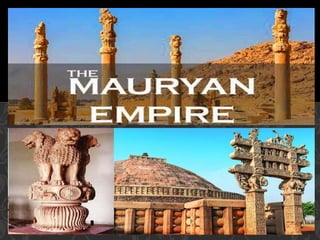
The Mauryan Empire
- 4. • Indica/Indika was written by Megasthenes (Greek Ambasador to Pataliputra). • He lived in Pataliputra for 5 years. • His book described: Organisation of army Administration of Pataliputra Economy Customs & Religion of the people. INDICA/INDIKA 4
- 5. • Arthashastra was written by Kautilya or Chanakya. • It has 6000 verses divided into 15 sections. • It describes: Administration Duties of the King Functions of ministers Organisation of civil service Information about diplomacy and relations with other kingdoms. It states that an Ideal State should provide relief to poor, orphans, old and infirm. And during famine opens state granaries should open their doors to those who are starving. ARTHASHASTRA 5
- 7. ASHOKAN EDICTS •An edict means an official order or proclamation. •EDICTS VII, XII & XIII. 7
- 8. 8
- 9. 9
- 10. • Erragudi (AP) • Girnar (Gujarat) • Sopara (Maharashtra) • Shahbazgarhi (Pakistan) ROCK EDICTS 10
- 11. •King Priyadarsi, Beloved of Gods wishes that people of all religious sections should live in harmony in all parts of his dominions. They should practice ‘liberality’ and should possess self-control and purity of thought. ROCK EDICT VII @ SHAHBAZGARHI 11
- 12. •Non Violence •Truthfulness •Obedience to parents & elders •Respect towards teachers. ROCK EDICT XII @ SHAHBAZGARHI 12
- 13. •Beloved of Gods, the King, considers victory of Dhamma to be the foremosr victory. ROCK EDICT XIII @ SHAHBAZGARHI 13
- 15. • Lumbini Pillar/Rummindei Pillar stated: ‘King the beloved of the Gods, visited this spot in person & offered worship at this palace, because the Lord Buddha was born here.’ (King Ashoka has visited & worshipped this place as this is the birth place of Lord Buddha.) INSCRIPTIONS ON PILLARS 15
- 16. • Lauriya-Nandangarh • Rampurva Pillar • Delhi-Topra which stated: it consists of virtuous deeds, compassion, liberality, truthfulness and purity. OTHER PILLAR INSCRIPTIONS 16
- 17. 17
- 19. • Stupa is a semi-spherical dome made of unburnt bricks and stones. • It was built to commemorate a sacred spot or event Or it had a Spiritual body of Buddha containing his relics (hairs, articles, teeth, bones etc.) • Stupa at Sanchi was built in 3rd century BC by Ashoka at Sanchi (60kms from Bhopal in MP) • It has 4 gateways in four directions. • Original stupa had wooden railing which was later replaced by stone railing. SANCHI STUPA 19
- 20. • It had Four gateways from all four sides. • Sculptures on the gateways or every symbol in the structure denotes meaning or a story from Buddha’s life or stories from Jataka tales. • Buddha was represented in Symbolic forms like Lotus, Wheel or Throne under a pipal tree. • It shows highest form of architectural and technical skills of the people of this period. SANCHI STUPA 20
- 21. • The death and destruction caused during the famous war of Kalinga changed Ashok’s personality. • He stopped eating meat and gave up life of luxury. • He declared Buddhism as the religion of the State. • Prisoners of war were used for agricultural work which increased production and economic development. KALINGA WAR 21
- 23. • The system of administration of Mauryans was elaborate. • Chandragupta Maurya laid the foundation of the administration of the Mauryan Empire. • Bindusara didn’t change the system and followed the same system. • Ashoka however made some minor changes in the system of administration as per his requirement. MAURYAN ADMINISTRATION 23
- 24. •Features of Administration during Ashokas’ rule: 1. King & Council of Ministers 2. Network of Spies (Overseers/Gudhapurushas) 3. Sources of Revenue 4. Provincial Administration 5. District Administration 6. City Administration 7. Administration of Justice (cutting of nose, shaving offender’s hair, penalty to death) 8. Peace & Good Order (honesty, efficient administration & good eco & trade) 9. Productive Agriculture 10. Lucrative Trade (land & waterways, trade with Myanmar, Sri Lanka, sea route: Gujarat to Babylon) MAURYAN ADMINISTRATION (ASHOKA) 24
- 25. •State was divided into five Provinces (During Chandragupta Maurya’s rule State had Four Provinces, Kalinga was added by Ashoka) •The five provinces were as follows: 1. Taxila (Northern) 2. Ujjain (Western) 3. Tosali (Eastern) 4. Suvarnagiri (Southern) 5. Kalinga. PROVINCES DURING ASHOKAS’ RULE 25
- 26. 26 Terms Provincial Administration District Administration City Administration Head Governors- Provinces (Taxila, Ujjain, Tosali, Suvarnagiri) Rajukas- District Nagraka- Providing water, maintaining roads, public buildings, city towers etc. Other Posts Pradesikas- Smaller Provinces Yuktas- District Treasury Officer SIX BOARDS (5 Persons)- e.g. Trade & Commerce, Census of Population etc. Mahamatras- Heads of Departments Dhamma Mahamatras- promoted Religion KING
- 27. Revenue: • Land revenue from mines & forests • Revenue from manufactured goods • Tolls for using bridges and roads • Fines • Licence-fees • Tax would vary from 1/3rd/1/6th of the Produce Expenditure: construction of roads, bridges, wells, rest-houses and army. SOURCES OF REVENUE 27
- 28. • Good irrigation works such as at Sudarshan lake & fertile soil, agricultural economy flourished during this period. • Tax would vary from 1/3rd/1/6th of the Produce depending on the irrigation facility provided in that area. PRODUCTIVE AGRICULTURE 28
- 29. Principles: • Purity of Domestic life and truthfulness • Toleration • Ahimsa • True Ceremonial (kindness to living creatures & liberality to ascetics & Brahmins) DHAMMA 29
- 30. • No Royal Hunt • Religious tolerance • Donations to Brahmins and ascetics • Officers reminded people of duties • Dhamma Mahamatras propagated religion • Ashokan Edicts: taught people purity of life, religious tolerance, not to kill animals and be charitable.. • Royal Missionaries were sent to frontiers of empire and to Sri Lanka, Myanmar, Syria, Egypt and Macedonia. MEANS FOR PROPAGATION 30
